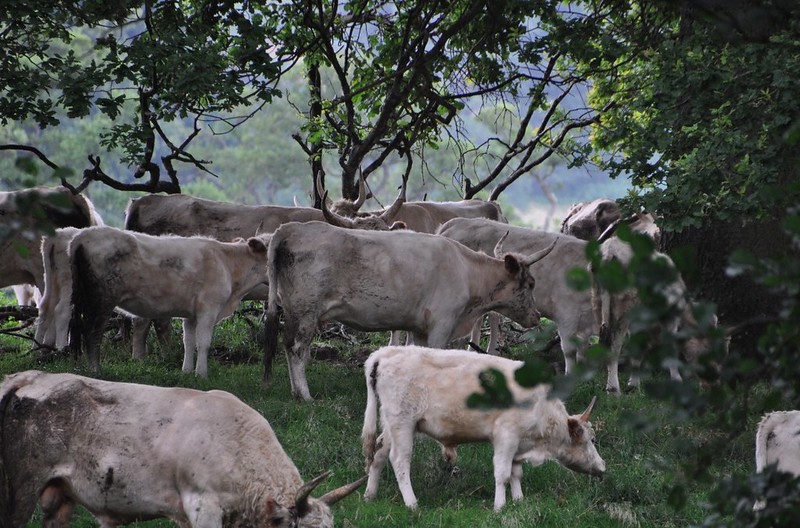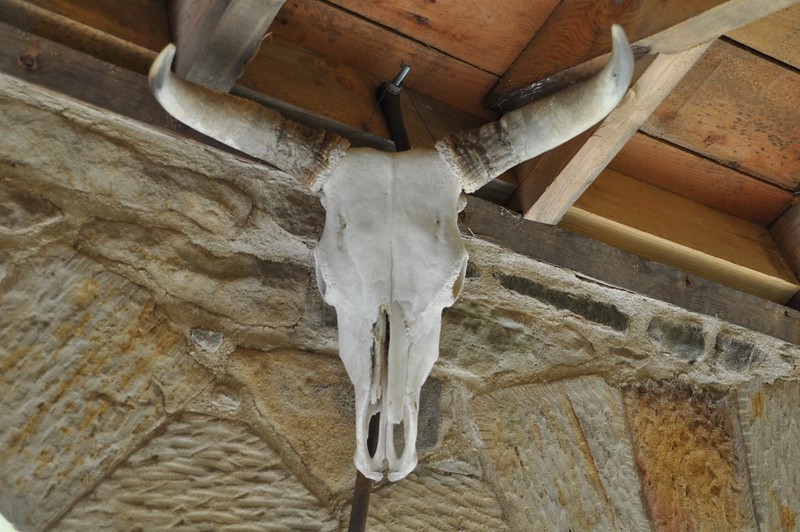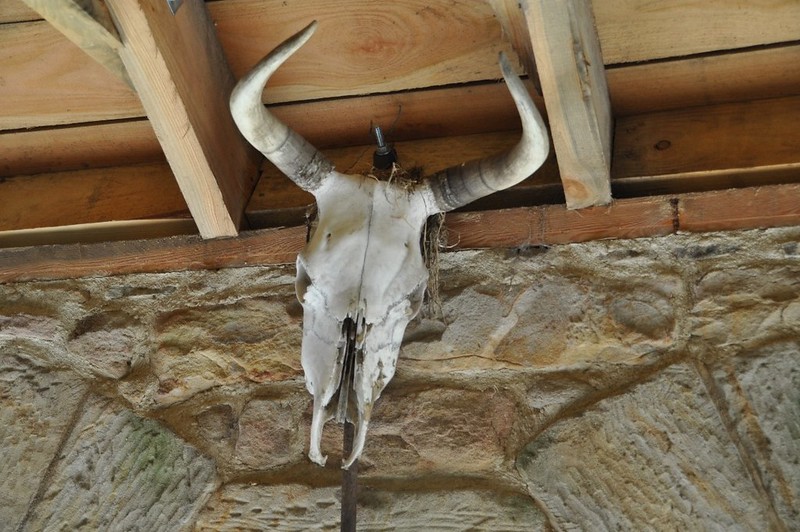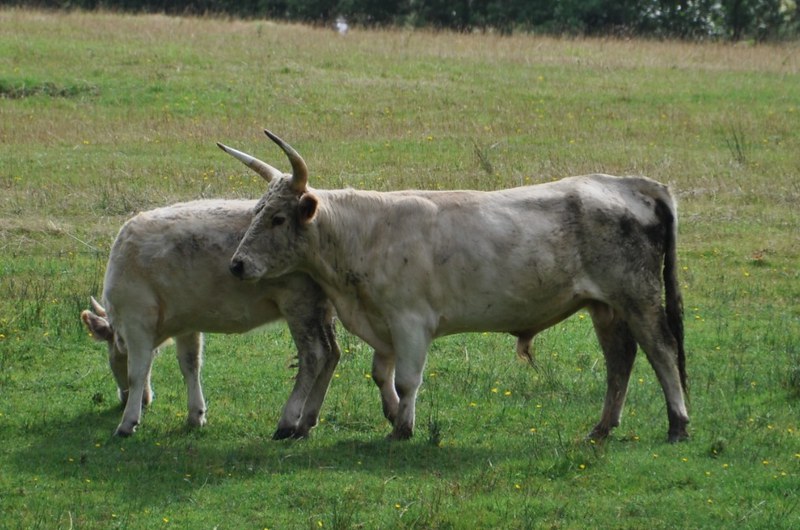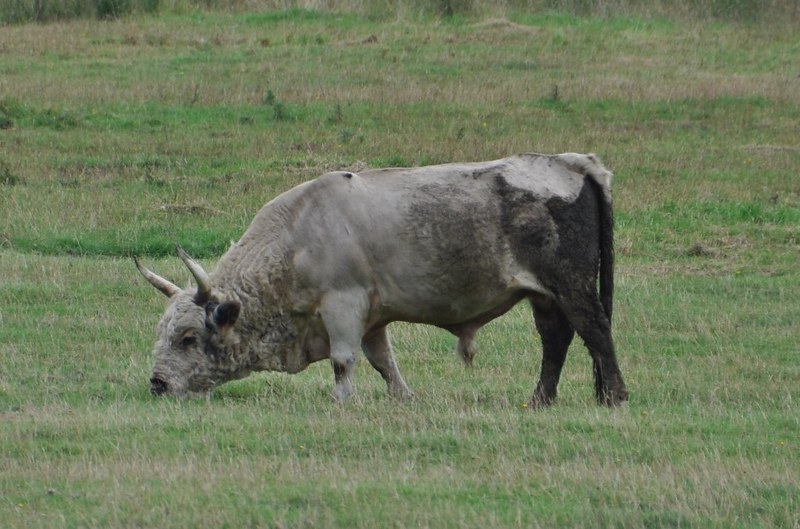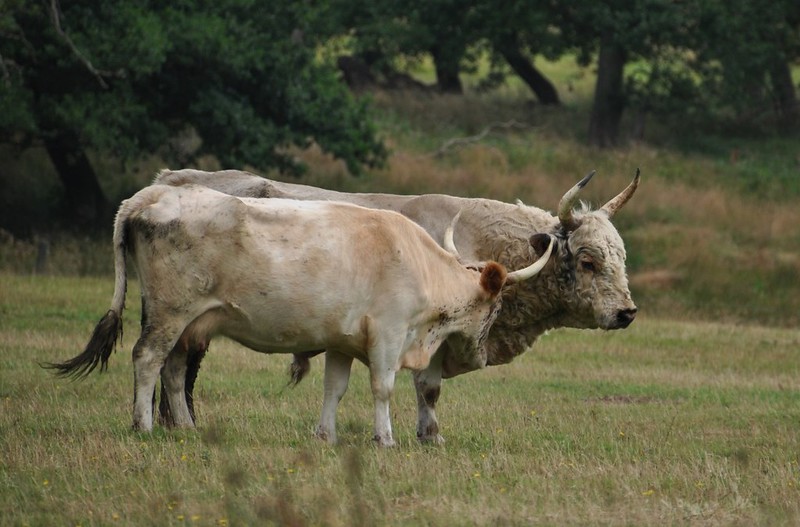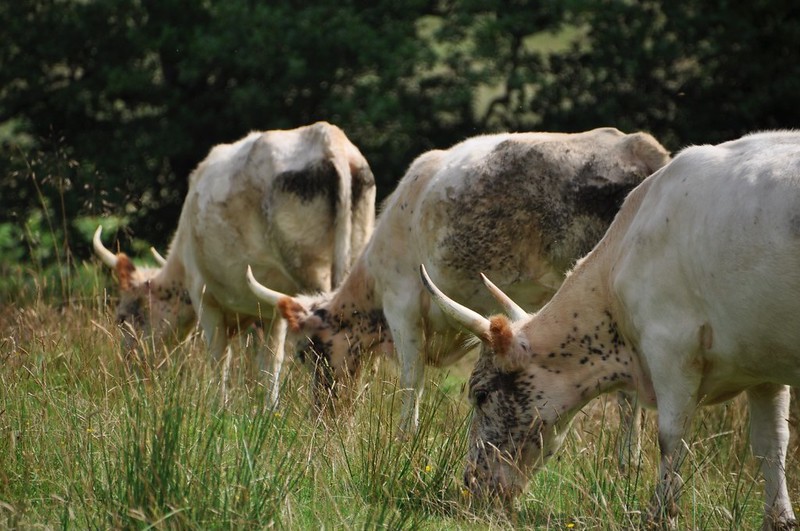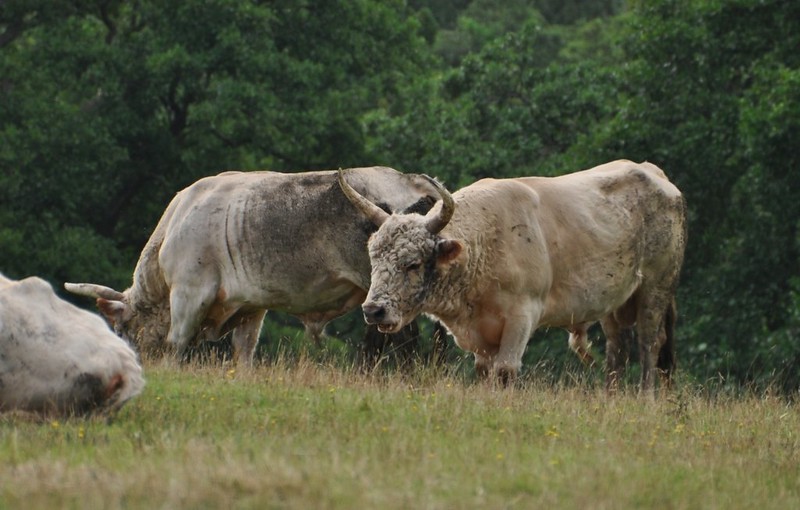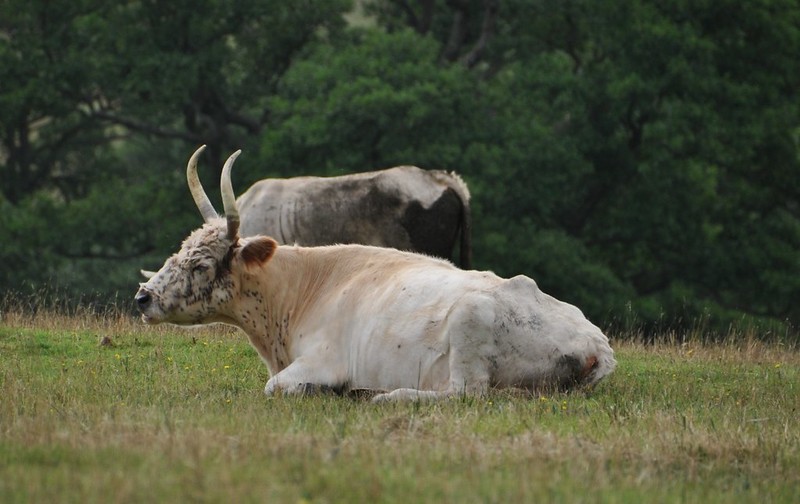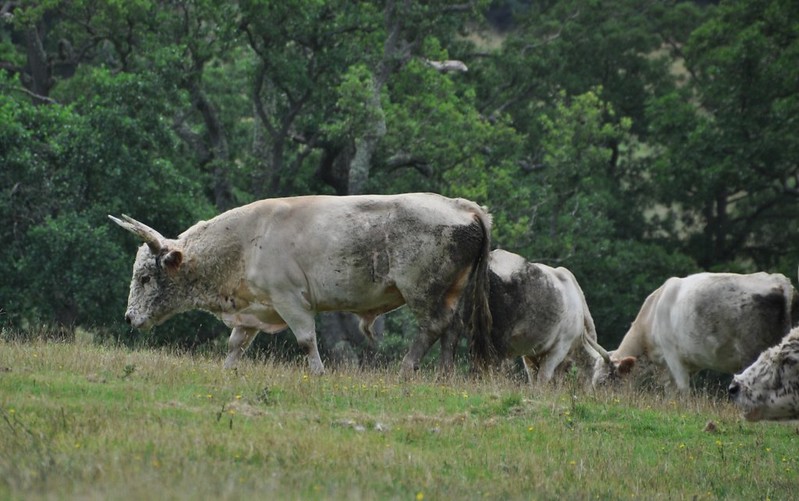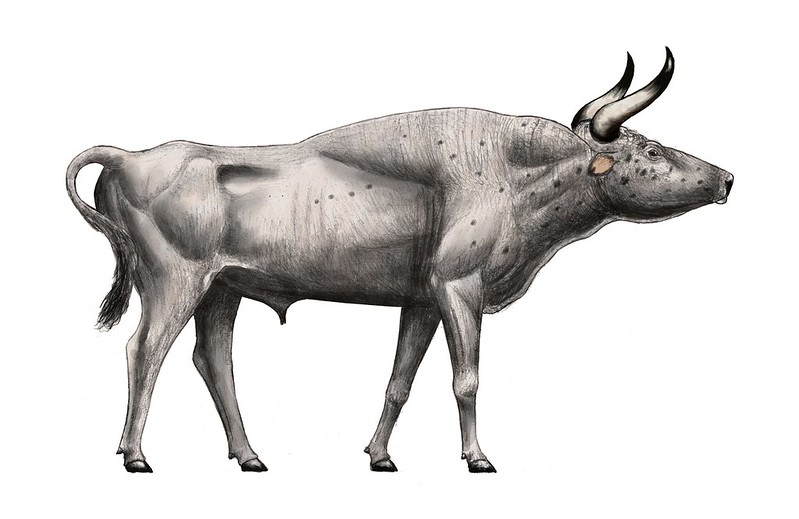In 1983, 32
Heck cattle were released in the Dutch reserve Oostvaardersplassen, an area of
5600 hectares. Oostvaardersplassen is the only place where Heck cattle live
under natural conditions without much influence of man, such as no
supplementary food during the first decades and no artificial selection. The
cattle grew to 350 individuals in 2011 and evolved into a very heterogeneous
population, making it a very interesting dedomestication experiment. It is cool
to see some individuals with broken horn tips, split ears or even scars; that
shows that they have a rough life and those which do best pass on their genes.
Keep in
mind though that Heck cattle in Oostvaardersplassen are by far not the only
free-ranging cattle population in Europe. Chillingham cattle and Betizu cattle
have been living freely since centuries,
and especially the last one is way more dedomesticated than the
Oostvaardersplassen cattle. Sadly though, feral cattle (or feral domestic
animals in general) are an ashamedly understudied field. Their social
behaviour, reproduction cycle, habitat choice, food selection, species
interaction and so on could tell us so much about their ancestral wild type,
the aurochs. And if it is a very variable population (what makes the
Oostvaardersplassen cattle so interesting here), a statistic evaluation of the
changing frequency of certain phenotypic features over the time would provide a
lucid example of evolution at work!
Most of the
Heck cattle at Oostvaardersplassen do barely resemble the aurochs. When people in the Netherlands started to buy Heck
cattle from other countries in the 1980s, the breeders mostly sold their less
good cattle (this is understandable, I would have done the same), and some
individuals were bought as calves, so that their quality was not yet
discernable. Therefore, most Dutch Heck herds, and the Oostvaardersplassen herd
in particular because no artificial selection takes place, are less
aurochs-like than many German herds, but there are also some good animals among
them (more on other Dutch herds in a future post).
Nevertheless,
the population at Oostvaardersplassen is very valuable because it has been
exposed to intense natural selection over the past 30 years. Predators are
still absent in the reserve, so the selective pressure mainly concerns the ability
to survive harsh winters, resistance against injuries and competition for food,
social dominance and breeding rights. I am not aware of any diseases in this
population.
The ability
to survive harsh winters and to live on poor forage is dependent on saving as
much energy as possible. This requires a thick and insulating winter coat (Heck
cattle, like other cold-resistant cattle breeds, have such a winter coat), but
also a small, hairy udder, short dewlap and short scrotum in order to reduce
the heath loss. Those individuals which loose too much energy during winter
cannot keep up sufficient strength or fall ill and die, what favours the cattle
that are more effective in saving energy and resist diseases. Storing fat
during autumn is another factor that is important for cattle to survive strong
winters. Also, seasonal adaption of the reproduction cycle is important for the
cow and calf’s survival, because cows having calves during the cold season have
difficulties in subsisting themselves and their offspring. Therefore, cattle
should mate during August/September and give birth during spring, like it
seemingly was the case in the aurochs [3], and is the case in Highland cattle
under natural conditions [3][2]. Heck cattle usually give birth all the year
round like most domestic cattle, unfortunately there is no information on the reproductive
cycle of the Oostvaardersplassen population that I am aware of.
The
competition for social dominance (which has advantages such as better feeding
places and less stress) and breeding rights is directly connected to the
animal’s superiority in intraspecific fights, which is dependent on the weight/size,
horns and also the psyche of the individual [1][2]. Long-legged and agile
animals also have a higher chance in succeeding in a fight. Intraspecific
fights occur in both sexes, but especially the mating competition of bulls has
a direct influence on the evolution within the population. High shoulder spines
that allow large neck and shoulder muscles to develop provide another important
advantage in combat; that’s the kind of “hump” that’s present in all wild
bovines, aurochs included. Also the horns of the aurochs were shaped for a
purpose: their curvature had a functional advantage in competitions, because
large, forwards and inwards-facing horns made it possible for the animal to
pull and push the opponent more effectively than other horn shapes would do.
This is the reason why bovine species fighting in a similar manner also have
very similar horns (Kouprey, Yak) and why the aurochs’ horns were relatively
uniform, no matter which respective time and region.
 |
| © treverius on flickr |
Having
tried to make predictions on how the functional phenotype (among other aspects)
of a released cattle population might change under such conditions, now lets
have a look at how the present Oostvaardersplassen Heck cattle look like.
The body shape of many cows is still domestic
in having a bulky rear, visible pelvic bones and no hump (thus, comparable to
usual Heck cattle). However, single cows seem to develop a slight hump and a
slender waist. This trend is even more apparent in bulls, some of which do
really have an athletic body shape with a clear hump and a slender waist,
resembling Spanish fighting bulls and wild bovines. Also, many bulls and cows
have long legs as in the aurochs. Therefore, the prediction that body shape and
proportions in a feral variable cattle population re-develops to an athletic,
aurochs-like body seems to be confirmed, because such a body conformation is
found in no other Heck cattle population. Down below you see screenshots of an Oostvaardersplassen bull (sadly with the wrong colour and horns) that has
perfectly aurochs-like body shape and proportions. However, there are still
some quite bulky and dachshund-proportioned Hecks in this reserve.
 |
| Slender, long-legged bulls |
The horns
within this population are mostly steppe cattle-like and thin, the length is
varying and they are oriented very upright both in bulls and cows. However, I
was surprised to discover cows with horns facing more forwards and inwards than
in any other Heck cows. This is a strong hint that this horn shape developed in
Oostvaardersplassen and therefore is a product of natural selection instead of
artificial selection. In essence, the curvature of the horns in these two
individuals is nearly perfect, except that they are oriented to vertical. I see
the same tendency several in other cows and also bulls in Oostvaardersplassen.
 |
| (© evoergo on flickr) |
 |
(© Frits van Hout) Cows with aurochs-like inwards-facing horns,
very likely a product of natural selection |
The skull
of the Oostvaardersplassen Heck cattle is short and paedomorphic like in most other
representatives of the breed. However, surprisingly some cows show an elongated
skull, similar to Sayaguesa. I wonder what causes this development and if a longer
snout perhaps provides an advantage for grazing, or if it is influenced by
environmental factors.
The colour
of those cattle is extremely variable. Dark brown bulls with a kind of saddle
and either dark or reddish-beige cows are most common, but black cows and black
bulls, as much as reddish brown or beige bulls do appear. Gray individuals exist
in both sexes and are a relatively common sight. The portion of spotted animals
seems to be higher than in usual Heck herds, unfortunately. These spots either are
limited to the forehead or cover the whole body.
 |
| Spotted bull calf (©Jaap Rouwenhorst) |
There is no
size data for the Heck cattle at Oostvaardersplassen, and also no useful photos
from which the size of the animals could be extracted, so we can only speculate
how large they are. Do the conditions in the reserve favour a size increase or
decrease against the 140 cm shoulder height in bulls and 130 cm in cows? As
discussed above, the natural selection created by the physical competition of
the animals likely favours larger animals. But considering the small size of
the reserve, the high density of herbivores and the limited amount of food, as
much as the absence of predators, makes Oostvaardersplassen a kind of island.
These island conditions favour a size decrease in larger animals, as numerous examples
of insular tetrapod evolution have shown. After all, the aurochs itself
“dwarfed” slightly on Sicily after it became isolated from the mainland. It
makes sense that a smaller animal needs less energy than a larger one, and a
healthy and strong small bull might succeed over a larger but emaciated one in
a competition. Therefore, we have to assume that the Heck cattle at
Oostvaardersplassen are as large/small as the average of the breed given above,
or even slightly smaller.
If the
conditions like they are now remain unchanged, how will the population in
Oostvaardersplassen develop in future decades? I think that on a middle- and
long-term sight, the portion of animals with an athletic body and aurochs-like
proportions and horns will increase, while the bulky and domestic looking ones
will get constantly fewer because these factors have a considerable impact on
the fitness of the animals. Also, if the food situation does not change (f.e.
by increasing the supplementary food that already is provided during winter),
those with the smalles udders and shortest dewlaps and scrota, and most
effective winter coat and resistance to diseases will become more common. The island situation of the reserve will
favour a size decrease more than a size increase. The colour of the animals has,
as far as we know and in the absence of predators, no direct influence on the
fitness of the cattle, so it will remain heterogeneous for a very, very long
time. Perhaps sexual selection favours dark bulls and lightly coloured cows,
but only on a very long term.
In essence,
future Heck cattle in Oostvaardersplassen will be more adapted to their habitat
and living as a wild animal than they are now. They probably will evolve into a
population with aurochs-like horns and proportions/body shape, but varying
colours and a small size. Probably it would also take a considerable time span
until these alleles are fixed, and I am speaking perhaps of centuries. But what
if man would “help” natural selection to speed up the process? Individuals with
undesired features, such as grayish coat colour and steppe cattle-like horns,
or many of the spotted individuals, could be culled, and a wild type colour
with the right sexual dimorphism could be fixated. To compensate the loss of
individuals, cows of herds that add what is lacking in the population can be
added, such as from the Wörth herd (for the horn dimensions and curvature) and the
Taurus cattle at Lippeaue (for the size, proportions/body shape and horn
curvature). Later culling should focus on the bulls in order not to decrease
the population too much, and because single bulls have a greater influence on
the evolution within the population than single cows.
This plan
could lead to a dedomesticated, wild cattle population that is adapted to their
habitat and resembles the aurochs very
well. However, it is up to the responsible people if this is turning into
reality or not.
It seems
that the next step in Oostvaardersplassen will be expanding the reserve. The
plan of Oostvaardersland, a new 150 square kilometres large nature area that
would be formed by the connection of Oostvaardersplassen to the reserve
Hosterwold by a corridor named Oostvaarderswold, ran into political trouble.
This is a shame, as Oostvaardersland would be one of the most precious nature
areas in western Europe. Not only because of its rich avifauna and the wet
zones which are very important for the amphibian fauna, but also because it is
the only place in western Europe where large populations of cattle, deer and
horses live side by side. Also, the cattle would have the chance to chose
between forests and open grassland, what would tell us more about the habitat
preference of this species. However, let’s stay tuned and see if
Oostvaardersland is going to happen.
Literature
[1] Frisch,
Walter: Der Auerochs – das europäische Rind. 2010.
[2] Julia
Poettinger: Vergleichende Studie zur Haltung und zum Verhalten des Wisents
und des Heckrinds. 2011.
[3] van Vuure, Cis: Retracing the Aurochs - History, Morphology
and Ecology of an extinct wild Ox.


